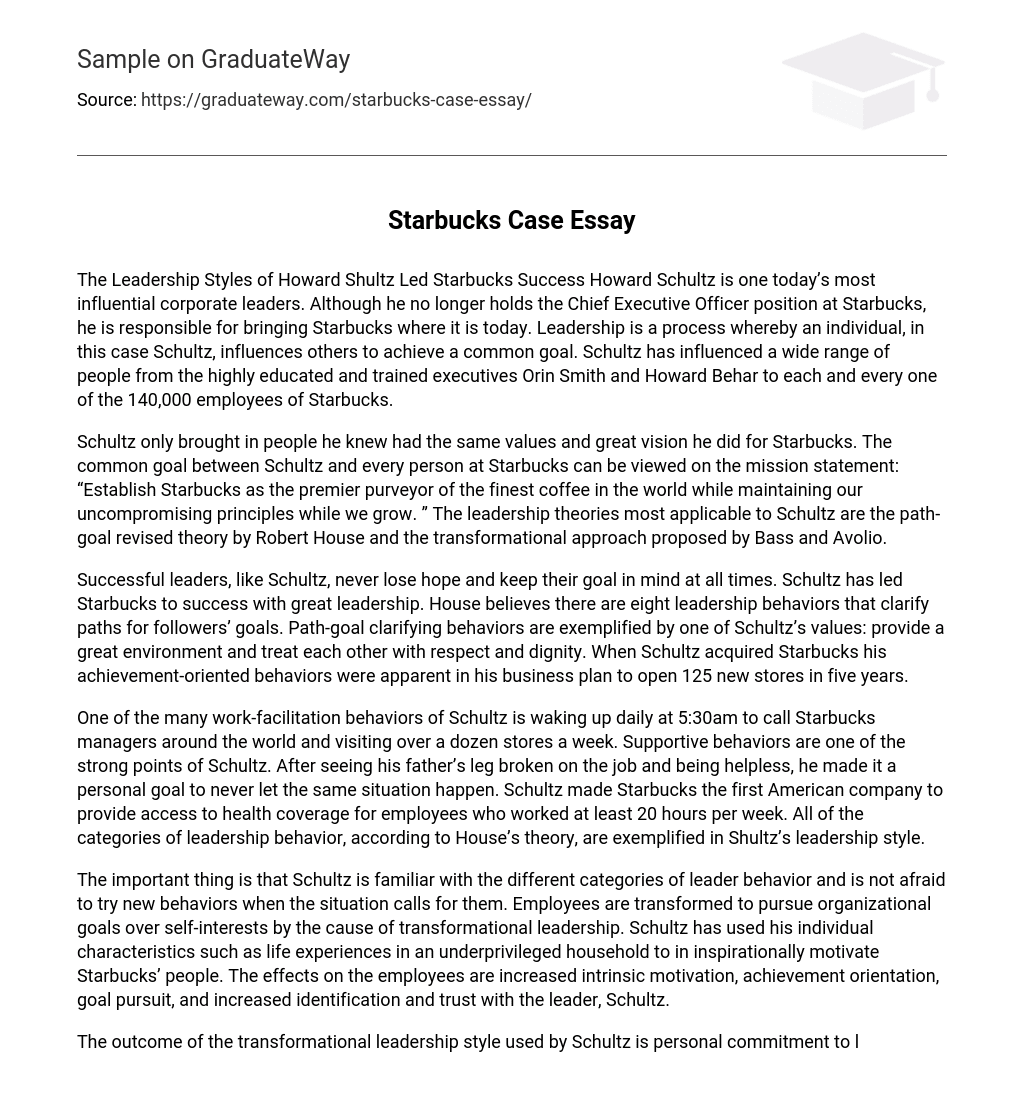Howard Shultz’s leadership styles are instrumental in the success of Starbucks. Despite no longer being the CEO, he played a crucial role in shaping the company’s current state. Leadership involves an individual, namely Shultz in this case, motivating others to work towards a shared objective. Shultz’s influence extends to a diverse set of individuals, including highly educated executives like Orin Smith and Howard Behar, as well as every single one of the 140,000 Starbucks employees.
Schultz handpicked individuals who shared his values and shared his extraordinary vision for Starbucks. The mission statement at Starbucks reflects the collective objective of Schultz and every Starbucks employee: “To establish Starbucks as the top provider of the finest coffee globally, while remaining committed to our unwavering principles as we expand.” Schultz’s leadership style aligns most closely with Robert House’s revised path-goal theory and the transformational approach suggested by Bass and Avolio.
Successful leaders, such as Schultz, maintain unwavering determination and consistently focus on their objectives. Schultz’s exceptional leadership has been instrumental in Starbucks’ triumph. House identifies eight specific leadership behaviors that help followers clearly navigate their goals. One of Schultz’s core values, exemplifying path-goal clarifying behaviors, is to foster a positive environment and treat everyone with respect and dignity. Schultz demonstrated his achievement-oriented behaviors when he acquired Starbucks and devised a business plan to establish 125 new stores within five years.
Schultz exhibits several work-facilitation behaviors, such as waking up at 5:30am daily to call Starbucks managers globally and visiting over a dozen stores weekly. Supportive behaviors are a strength of Schultz. Witnessing his father’s job-related injury and feeling powerless, he vowed to prevent this from happening to others. Consequently, Schultz ensured that Starbucks became the initial American company to offer health coverage to employees working a minimum of 20 hours per week. All aspects of leadership behavior outlined in House’s theory are evident in Schultz’s leadership style.
Schultz’s familiarity with different categories of leader behavior enables him to embrace new behaviors when necessary. Through transformational leadership, employees are motivated to prioritize organizational goals over self-interests. Schultz’s personal experiences, particularly growing up in an underprivileged household, serve as inspiration to motivate Starbucks’ staff. As a result, employees experience heightened intrinsic motivation, a stronger drive for achievement, a focus on goal attainment, and an increased sense of identification and trust towards Schultz as their leader.
The use of Schultz’s transformational leadership style results in personal commitment to the leader and vision, task meaningfulness and satisfaction, as well as improved individual, group, and organizational performance. This level of commitment among organizational members leads to high customer satisfaction, ultimately contributing to the success of Starbucks. Additionally, Howard Schultz’s individual differences play a role in shaping his identity and distinguishing him from others.
Individual differences are crucial for the success of an organization. Similar to Schultz, every person has a self-concept encompassing self-esteem, self-efficacy, self-monitoring, and organizational identification. In my opinion, the most influential individual difference that has contributed to Schultz’s success is his self-efficacy. Additionally, organizational identification has significantly influenced both Schultz and Starbucks’ triumph. Self-efficacy refers to one’s belief in their capability to achieve a specific task, an attribute Schultz has consistently displayed.
He has always possessed the belief that he can achieve success. Schultz’s strong self-efficacy stems from his resilient mother who constantly encouraged him to have faith in America and in his abilities to accomplish anything he desires, despite their family’s financial struggles. Additionally, Schultz’s unwavering dedication for triumph is fueled by his fear of failure. Witnessing his father’s frustration and lack of respect as he moved from one manual job to another, Schultz recognized the significance of achievement and education.
According to Albert Bandura’s self-efficacy model, engaging in behaviors like selecting opportunities, setting goals, planning, preparing, practicing, problem-solving, and visualizing success leads to successful outcomes. Schultz displayed his problem-solving abilities by dedicating two weeks to creating a different plan that prevented a notable decrease in his ownership stake from one of the original investors based in Seattle.
The concept of organizational identification involves merging an individual’s self-identity with their organization’s values and beliefs. Schultz has fully embraced Starbucks, genuinely endorsing its principles. Furthermore, his strong connection to the organization greatly influences his success. For instance, he consistently prioritizes customer satisfaction in line with Starbucks’ mission, even outside of work. It is important to highlight that personal attributes such as self-efficacy and organizational identity hold significant importance in both Schultz’s personal accomplishments and Starbucks’ overall success.





